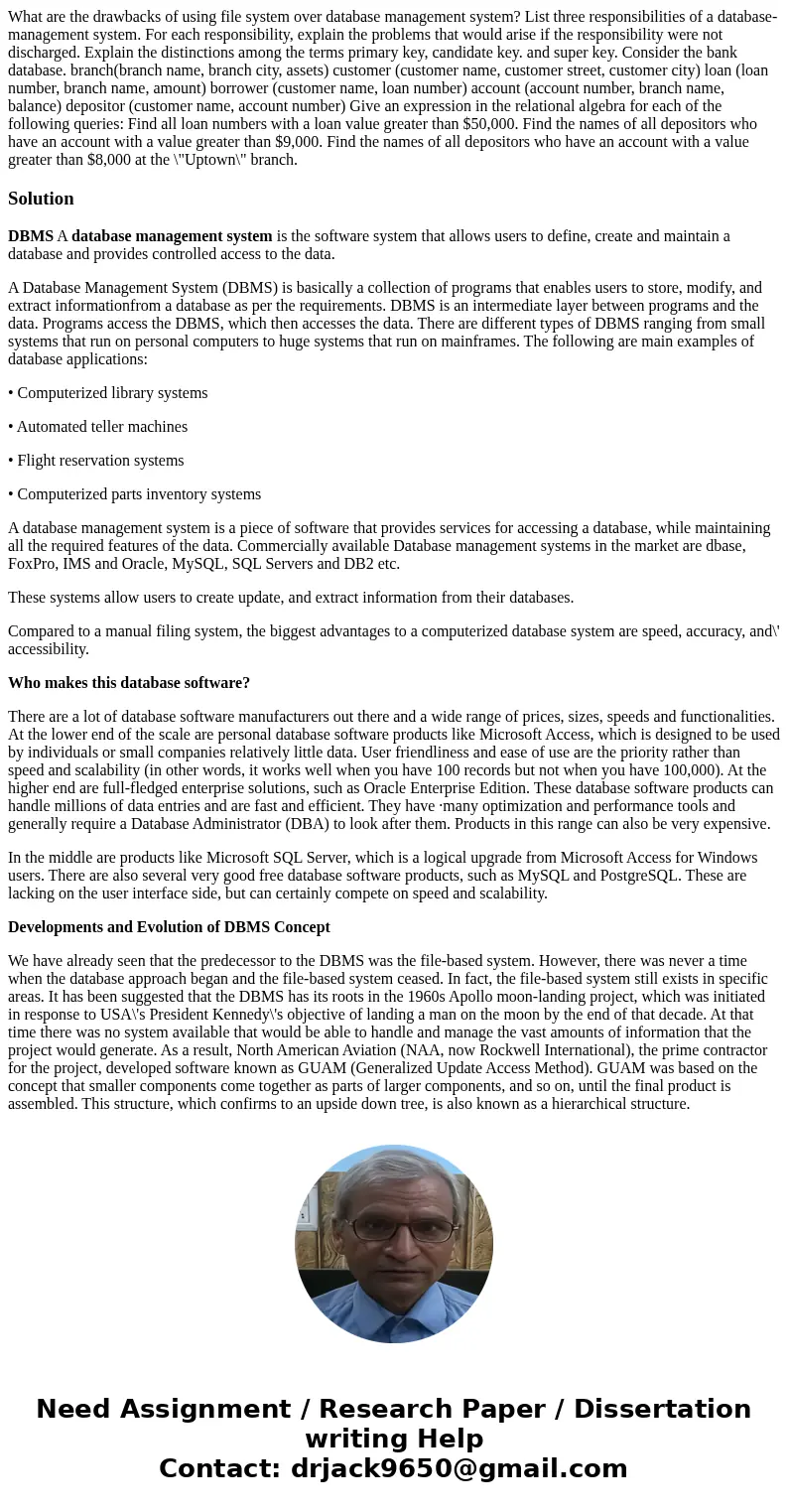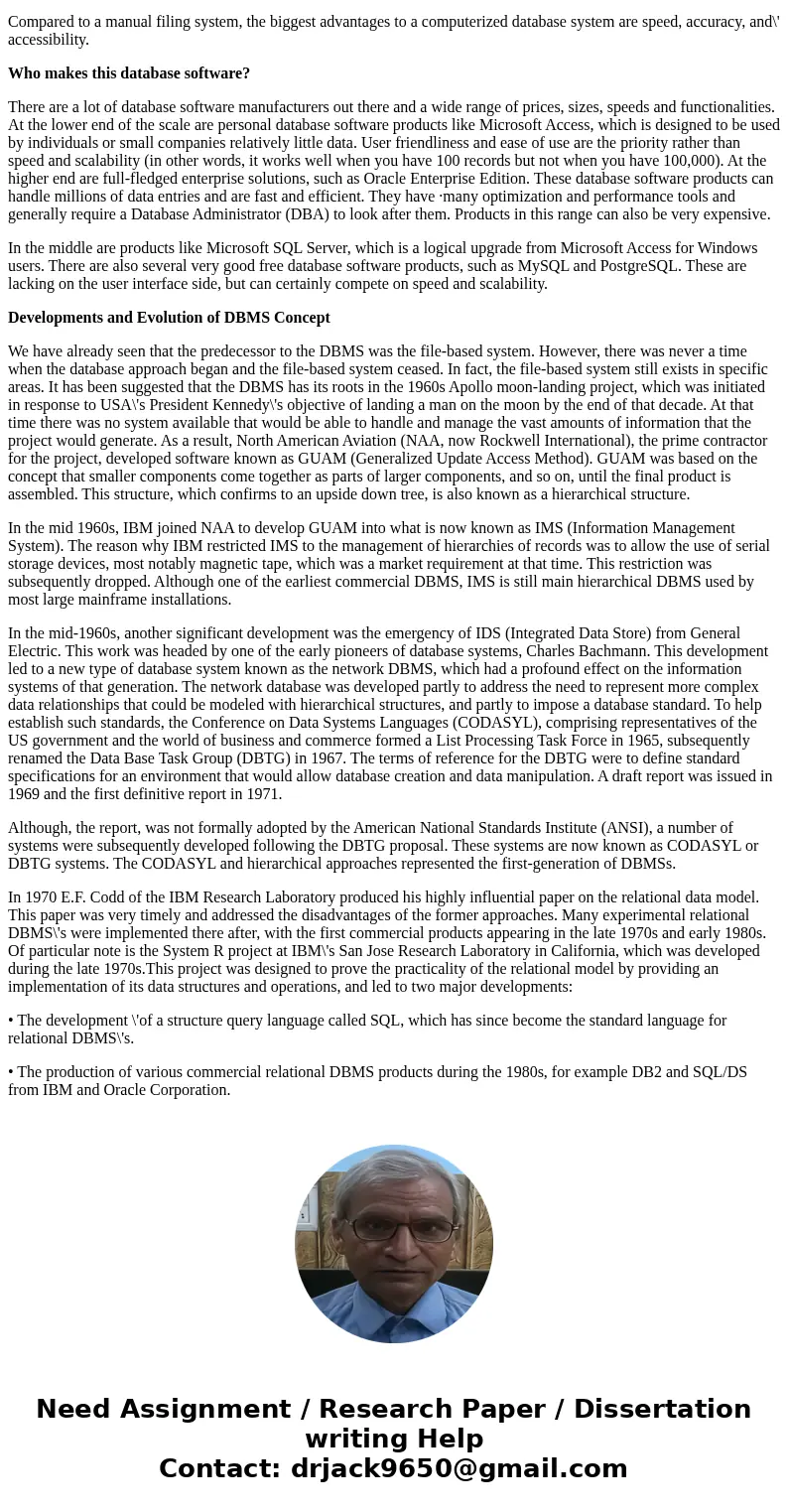What are the drawbacks of using file system over database ma
Solution
DBMS A database management system is the software system that allows users to define, create and maintain a database and provides controlled access to the data.
A Database Management System (DBMS) is basically a collection of programs that enables users to store, modify, and extract informationfrom a database as per the requirements. DBMS is an intermediate layer between programs and the data. Programs access the DBMS, which then accesses the data. There are different types of DBMS ranging from small systems that run on personal computers to huge systems that run on mainframes. The following are main examples of database applications:
• Computerized library systems
• Automated teller machines
• Flight reservation systems
• Computerized parts inventory systems
A database management system is a piece of software that provides services for accessing a database, while maintaining all the required features of the data. Commercially available Database management systems in the market are dbase, FoxPro, IMS and Oracle, MySQL, SQL Servers and DB2 etc.
These systems allow users to create update, and extract information from their databases.
Compared to a manual filing system, the biggest advantages to a computerized database system are speed, accuracy, and\' accessibility.
Who makes this database software?
There are a lot of database software manufacturers out there and a wide range of prices, sizes, speeds and functionalities. At the lower end of the scale are personal database software products like Microsoft Access, which is designed to be used by individuals or small companies relatively little data. User friendliness and ease of use are the priority rather than speed and scalability (in other words, it works well when you have 100 records but not when you have 100,000). At the higher end are full-fledged enterprise solutions, such as Oracle Enterprise Edition. These database software products can handle millions of data entries and are fast and efficient. They have ·many optimization and performance tools and generally require a Database Administrator (DBA) to look after them. Products in this range can also be very expensive.
In the middle are products like Microsoft SQL Server, which is a logical upgrade from Microsoft Access for Windows users. There are also several very good free database software products, such as MySQL and PostgreSQL. These are lacking on the user interface side, but can certainly compete on speed and scalability.
Developments and Evolution of DBMS Concept
We have already seen that the predecessor to the DBMS was the file-based system. However, there was never a time when the database approach began and the file-based system ceased. In fact, the file-based system still exists in specific areas. It has been suggested that the DBMS has its roots in the 1960s Apollo moon-landing project, which was initiated in response to USA\'s President Kennedy\'s objective of landing a man on the moon by the end of that decade. At that time there was no system available that would be able to handle and manage the vast amounts of information that the project would generate. As a result, North American Aviation (NAA, now Rockwell International), the prime contractor for the project, developed software known as GUAM (Generalized Update Access Method). GUAM was based on the concept that smaller components come together as parts of larger components, and so on, until the final product is assembled. This structure, which confirms to an upside down tree, is also known as a hierarchical structure.
In the mid 1960s, IBM joined NAA to develop GUAM into what is now known as IMS (Information Management System). The reason why IBM restricted IMS to the management of hierarchies of records was to allow the use of serial storage devices, most notably magnetic tape, which was a market requirement at that time. This restriction was subsequently dropped. Although one of the earliest commercial DBMS, IMS is still main hierarchical DBMS used by most large mainframe installations.
In the mid-1960s, another significant development was the emergency of IDS (Integrated Data Store) from General Electric. This work was headed by one of the early pioneers of database systems, Charles Bachmann. This development led to a new type of database system known as the network DBMS, which had a profound effect on the information systems of that generation. The network database was developed partly to address the need to represent more complex data relationships that could be modeled with hierarchical structures, and partly to impose a database standard. To help establish such standards, the Conference on Data Systems Languages (CODASYL), comprising representatives of the US government and the world of business and commerce formed a List Processing Task Force in 1965, subsequently renamed the Data Base Task Group (DBTG) in 1967. The terms of reference for the DBTG were to define standard specifications for an environment that would allow database creation and data manipulation. A draft report was issued in 1969 and the first definitive report in 1971.
Although, the report, was not formally adopted by the American National Standards Institute (ANSI), a number of systems were subsequently developed following the DBTG proposal. These systems are now known as CODASYL or DBTG systems. The CODASYL and hierarchical approaches represented the first-generation of DBMSs.
In 1970 E.F. Codd of the IBM Research Laboratory produced his highly influential paper on the relational data model. This paper was very timely and addressed the disadvantages of the former approaches. Many experimental relational DBMS\'s were implemented there after, with the first commercial products appearing in the late 1970s and early 1980s. Of particular note is the System R project at IBM\'s San Jose Research Laboratory in California, which was developed during the late 1970s.This project was designed to prove the practicality of the relational model by providing an implementation of its data structures and operations, and led to two major developments:
• The development \'of a structure query language called SQL, which has since become the standard language for relational DBMS\'s.
• The production of various commercial relational DBMS products during the 1980s, for example DB2 and SQL/DS from IBM and Oracle Corporation.


 Homework Sourse
Homework Sourse